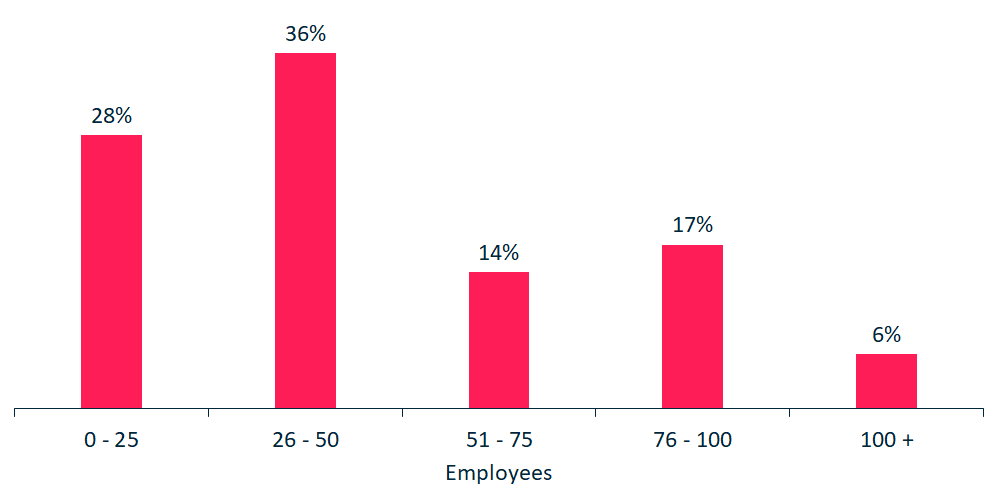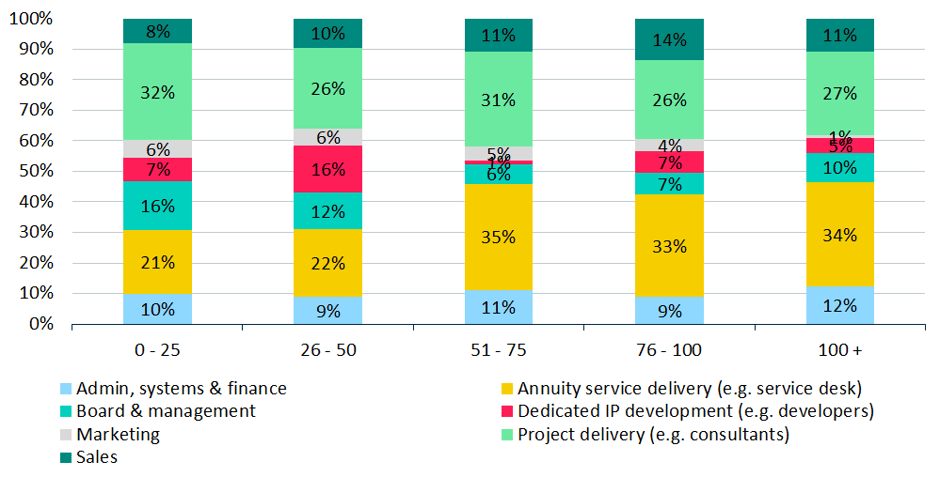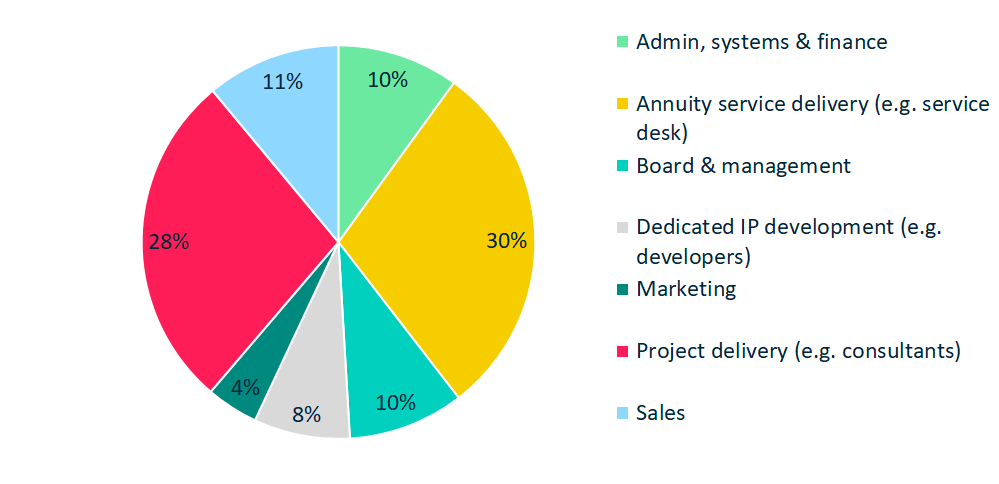
July 26, 2022
In this chapter of our Microsoft Partner Insights series we dig a little deeper into how Microsoft Partners and their employees have handled the much reported ‘return to the office’.
People – Your greatest asset
But first, who makes up the workforce of the 50 companies we invited to take part?
In line with last year’s research , Microsoft Partners employing between 26-50 people were the most represented in this year, accounting for 36% of respondents, followed by 28% of the group who have a headcount of up to 25 employees. The largest companies in the survey with over 100 staff only accounted for only 6%.
Total company headcount

When looking at the average headcount split by department, there was once again little change from last years group. The biggest departments were ‘annuity service delivery’ with 30% (down from 35% last year) and ‘project delivery/consultants’ who accounted for 28% on average (26% in 2021). This reflects the fact that a large proportion of the participating businesses were Managed Service Providers (MSP) or System Integrators (SI)/Professional Services Consultancies.
Average Headcount % Split by Department
When re-categorising these results based on the total company headcount buckets it was interesting to see how the different sized businesses weight their functions.
Average Headcount % Split by Department & Total Company Headcount

Sales, administration and project delivery departments were roughly in line with each other regardless of company size. There was a tilt towards a higher weighting in annuity service delivery teams for the larger organisations, with firms of 50+ employees allocating between 33-35% of their workforce here, this compares to just 21-22% for Microsoft Partner with less than 50 employees.
It was expected that ‘board & management’ would account for a higher percentage of the workforce on average in the smaller participating companies versus the larger organisations.
The office: To return or not return… that is the question!
The pandemic forced a shift in working patterns that, for many Microsoft Partners and their employees, has continued long after government restrictions and guidelines ended. We were interested to hear the thoughts of the CEOs on how their businesses had handled the return to the office. Where possible, we have included direct quotes taken from a series of 1-to-1 interviews with the senior leaders at some of the UK’s most successful Microsoft Partners.
Due to the Government lockdown, the number of people working from home rose dramatically during at the start of the pandemic, from 5.7% of workers in January 2020 to 43.1% in April 2020 (WISERD Homeworking report Aug-2020 ). However it’s the homeworking statistics and policies as we emerge from the other side of the pandemic that are really interesting as we consider whether office work will ever return to the way it was. Should you adopt a fully remote, hybrid working or fully back to the office approach? This was the question on everybody’s mind.
Is fully remote the future?
Within our cohort there was a wide mix of responses when we discussed this topic in detail. A small percentage of the group either already had no physical office space or had fully adopted remote working practices prior to the pandemic. So for them it was almost ‘business as usual’.
- “We have been location agnostic for years, but everyone became this way during COVID. We were never office grounded. We let people choose where they worked. We’ll see more of people working out of client offices.”
- “Nothing has changed. We have always been remote working.”
- “In our staff survey some of our people are saying why do we have to come in at all.”
- "We have actively decided we don’t want people to return to the office.”
The percentage of U.K. workers who in 2018 worked mainly from home was 13.9%. (Statista - Working from home rate UK 2020).
However this number has shifted significantly since then. For workers earning £40,000 or more for example, 42% said they expect to work mainly from home going forward “with an additional 23% working exclusively from home” (FT/ONS).
Many employers are letting employees choose
Where we started to see a consensus amongst the Microsoft Partners we interviewed was around giving employees significant flexibility. Within this group some CEOs interviewed were happy to let employees decide where they would like to work:
- “My approach has been activity based and have elected to empower people to choose on the most suitable location to do their work.”
- “We haven’t forced it on anyone. I don’t see us coming back full-time. I think 2-3 days a week will be it.”
- “2 to 3 days a week in the office is where we think we will get to. We will have a day as a Board where everyone is in the office. Think we will largely let people self-manage when they are in.”
- “We have everyone in pretty much 5 days a week. We haven’t said people have to be in. We have a lot of younger people, and realised it was going to be really hard for them, so we’ve all come back in.”
- “We did the whole work from home thing. Our office is now open, and a number of people are going into the office on a voluntary basis.”
- “I don’t get the sense that people want to go back to commuting.”
- “People are self-managing days in the office, however, we are extolling the virtues of coming in.”
- “In our staff survey some of our people are saying why do we have to come in at all.”
- “We anticipate 50/50. We like keeping an office. It’s heaving at the moment.”
Others on the other hand had either rolled out an official hybrid working policy and mandated some level of attendance in the office, or were at the very least encouraging people to come in at some point during the week.
- “Currently we are encouraging people to come in a couple of days a week. On certain days, the office is reserved for certain teams. We downsized the office so don’t have a desk for everyone.”
- “We have more people demanding hybrid working.”
- “Mostly staff are still working from home, we have mandated a day a week.”
- “As soon as lockdown restrictions were limited, we encouraged people to come back. Mandated it. We’ve changed it since I arrived. From November, we introduced a flexible working guiding principle (not a policy). Companies feel the need for a form of control i.e. say 1 day a week. We stated what was important to us and then left it for employees to determine how they work within that.”
- “We are asking senior team members to come in 2 days a week if they are local.”
- “There have been very mixed reaction to us saying it will be hot desking. Having the choice is the key. We are lucky there are 3 or 4 people are working in the office all the time, so that when a few people come in, there is already a core group.”
- “Our new policy mandates a minimum of 2 days per month, plus other additional company or client days. We will revisit and possibly increase to 4 days a month. But it is very much about giving people the choice.”
- "We don’t mandate office presence, but we have asked each team to nominate a day each week they will all be in the office."
There’s still a need for face-to-face human connection
The Office for National Statistics (ONS) reported that 85% of workers currently homeworking wanted to adopt a hybrid working pattern going forward. Several of the leaders we spoke to were keen to have people back in the office at least in part to enable face-to-face time between team members, to maintain office culture and to build rapport between colleagues.
- “After a couple of years of working remotely, there is a drive from teams and managers that they want to work together in person more.”
- “We are in two days each week so we can all see each other at the same time.”
- “We surveyed people and it is down to personality. The I.T. sector seems to have more people who would rather have more time at home. We’ve adopted a 3-day hybrid approach. It is a short-term approach to the situation. I think overall, people are missing being with each other and are coming back to the office a few days a week.”
- “Some people had a default position to work out of office, I think the default will now be people will work from home. People will come in for the social not the business reasons.”
- “Currently we are actively encouraging people being back in the office and the gains of being face to face.”
Office culture remains a focus for employers
In fact maintaining a great company culture was an area that many were focused on.
- “Our COO spent 15mins with every person in the business - over 50 meetings. One thing I primed him to feedback on was his sense of people’s experience of the culture i.e. someone who joined pre- and post-pandemic. His perception is that the culture was the same. Which is amazing! We do think about it a lot.”
- “It’s hard to build culture without an office, especially with young people, but its helped by the fact that this is how we started.”
While part of the formula for creating the right culture in a business today involves more flexibility for employees, for employers it’s important to ensure that the increased homeworking flexibility does not lead to increased isolation of team members and reduced employee engagement.
Innovation stagnation. Are you running out of ideas?
One CEO highlighted the loss of innovation due to remote working as the catalyst for encouraging staff back to the office.
“It’s been a very, very tough thing for us. We are really missing the innovation side of things. Being in the office is a great way to inspire and have the conversations you can’t do as effectively remotely.”
Many companies fear that they will lose their competitive edge due to increased remote working leading to less collaboration and innovation, however some research has shown (The Oxford Handbook of Group Creativity and Innovation 2019) that the larger the in-person group, the fewer new ideas each person has.
However the opposite happens for remote/virtual brainstorming, with more new ideas being produced the more people there are, leading to greater levels of innovation. This is partly attributed to the “balancing the preferences of introverts and extroverts, optimists and pessimists, lower-status and higher-status members.”
Productivity – Are you getting the most from your people?
Just as innovation a focus for some, for others it was productivity.
- “We do have a challenge with people on working from home days not being as productive.”
- “We had a problem with a guy who worked remotely. He never answered the phone and it turned out he was working two jobs.”
- “On working from home days with consultants, in particular, the work they have allocated for the day almost always runs into the next day.”
- “When we call people they aren’t on their phones, or they are out of breath because they haven’t been at their desks. The quality isn’t there and there are lots of mistakes.”
- “With developers there seems to not be any change in output.”
- “It can be hard to measure productivity. On projects it has gone up. Our billing utilisation is better now than it was. People are putting in more effort.”
The jury is still out on whether homeworking increases productivity or not. There is plenty of research to show that is it is beneficial due to the reduced amount of time employees spend commuting, a higher employee retention rate, plus other drivers such fewer interruptions and more focused work time.
However many experts and industry leaders, including Microsoft, have also been keen to point out that productivity can suffer due to the lack of collaboration, communication and mentorship.
A 2 year study by global authority on workplace culture, Great Place to Work summarised the link between productivity and remote working succinctly:
“Productivity of both in-person and remote work are influenced by the same key factors: leadership and healthy, supportive company culture. Workplaces that are strong in both can have high employee productivity no matter where their desks may be.”
Employee wellbeing and mental health
The impact of hybrid and remote working on employee wellbeing has rightly been at the centre of many homeworking discussion since the start of the pandemic. And while remote working has definitely benefited many employees, others are now working more hours, spending more time in low-quality meetings, more time juggling home and work life requirements, and ultimately more stress. It was clear during our interviews that this was a big concern for several of the Microsoft Partners.
- “I have been horrified at how many people have hit mental health issues during the pandemic. We have taken out insurance to the highest level including in-patient care, which we feel is important given the strain on NHS.”
- “We do all company meetings twice a month. And 30 minutes twice a day to do physical exercise.”
- “We don’t ask how people spend their time or what they are doing. It would be very rare for people not to go for a walk or run, people manage their own time.”
And they were right to be concerned, a March 2021 study by the Journal of Occupational Environmental Medicine found that 66% of respondents reported new physical health symptoms since beginning to work from home, 75% reported new mental health issues, mainly depression and anxiety.
Back to the office – Risky business?
It was interesting to see a number of Partners who had reverted to being either fully back in the office or close to it.
- “We are all back in the office. The sales team are in only Monday and Fridays, but they are out and about during the week.”
- “Before COVID we were office based, albeit customer facing teams. Sales and pre-sales would be on or off-site as the work dictated. That hasn’t change since COVID. The rest of the business went fully back, and we came back quite early.”
- “We brought the service desk back, as we found a better service to the customer.”
- “We haven’t had issues with people not wanting to be in the office. People just haven’t wanted to be at home. Everyone has been super keen to come back in.”
The challenge for Microsoft Partners pushing for a complete return to the office is in retaining and attracting staff. There is now fierce competition in the recruitment market place and many tech companies are willing to offer fully or partially remote working roles.
With increased flexibility becoming the new ‘normal’, can businesses afford to break from the ranks and revert to pre-pandemic working practices? Harvard Business Review for example found that “40% of U.S. employees would start looking for another job or quit immediately if ordered to return to the office full time.”
Office Space
Cost vs Benefit
For most business owners the discussion around remote, hybrid, or office based working has to be considered against the backdrop of commercial property costs and sparsely used office space. Can you justify having the cost of having an office if it’s only going to be 50% full?
Many had take the decision some time ago to either downsize or get rid of the office all together and the numbers just didn’t make sense.
- “I have an office and only 5 seats are ever used. I don’t think it will be there in a few months.”
- “Our lease comes up next year and we will have to decide. My head says lose the office. My heart says don't do it.”
- “We downsized from 70 to 12 desks in managed services.”
- “We had offices but got rid of them during lockdown.”
- “We are moving premises and downsizing from mid-50 headcount to 30 desks.”
- “We gave up our London office in March 2021. People were radiating out around the globe – they emigrated while still working for us. We now don’t have an office. We have been asking people do you want to come back in, and the overwhelming message is that people don’t want an office again. A few people have just recently said it would be nice to have an office again. Maybe we will move back to a premises at some point – possibly a flexible space.”
Office shake-up
Some of the CEO’s in the group had opted to reassess how they use the office and adjust the set-up accordingly.
- “I’d like to see people want to come into the office. We are going to turn our spaces more into communal space. Not about socially distanced desks.”
- “We have shrunk our space by a third and tried to make it a bit smarter.”
Some of the world’s leading tech companies, such as Amazon, Google, Microsoft and Facebook, have been refitting their offices with more and more amenities such as additional collaborative working spaces, peloton studios, and music and games rooms in an effort to attract people back to the office.
Offices on-demand
For some of the other Microsoft Partner leaders in the group the answer lay in co-working or flexible work spaces/offices such as We Work or Bizspace.
- “We have flexible offices in Manchester, London and Reading. Spaces for people to land in as needed. People can come in as much or as little as they need. We ask them to say what their plan is i.e. 3 days a week and we set up their membership accordingly. Used to use WeWork but found them not very friendly, a bit too corporate”
- “We had an office which had a capacity for 70 desks, but we were only getting 4 people a day coming in. We now have about 20 desks in a co-working space on a 12-month rolling contract.”
The rise in the number of global co-working spaces has been phenomenal in recent years. According to MIT Sloan Management Review there were only 106 worldwide in 2008, where this number exploded to approximately 19,000 in 2018. A while the industry took a huge hit during the pandemic, analysts predict co-working spaces will become even more important and popular in future.
Moving forward – Things to consider
To mandate a return to the office leadership teams need to be clear on why they want employees to return. The are many ‘why’ areas to consider such as:
- Collaboration
- Innovation
- Social interaction
- Connectivity
- Communication
- Maintaining culture
- Mentorship
- Productivity
- Compliance
- Employee wellbeing
- Engagement
- Employee retention/attrition
Without clarifying the ‘why’ it is very difficult to think about the next stage and ‘how’ do you do that.
Do you have a legal question for us?
Whether you are just getting started, need a template package or just some legal advice for your business, we are here to help with any questions you may have.
Our mission is to help you succeed, with less risk.
